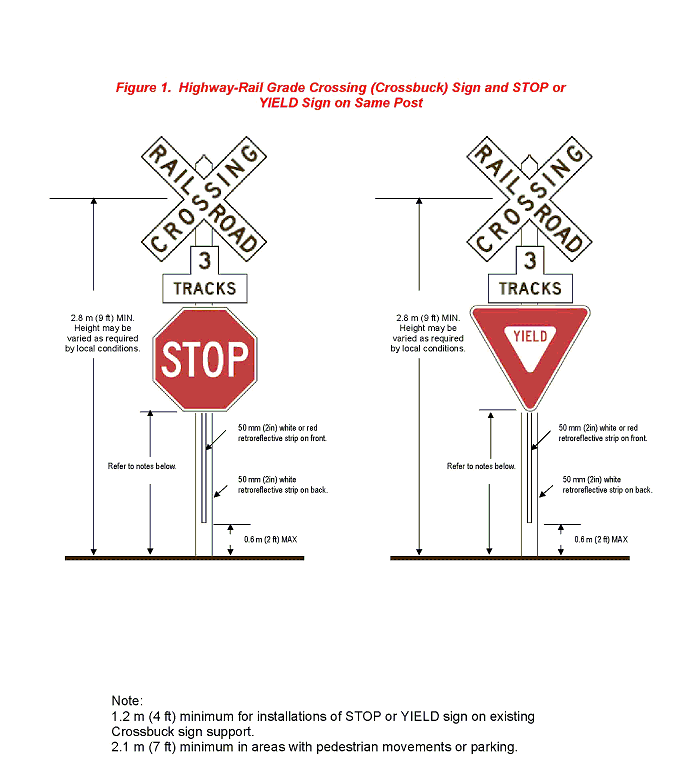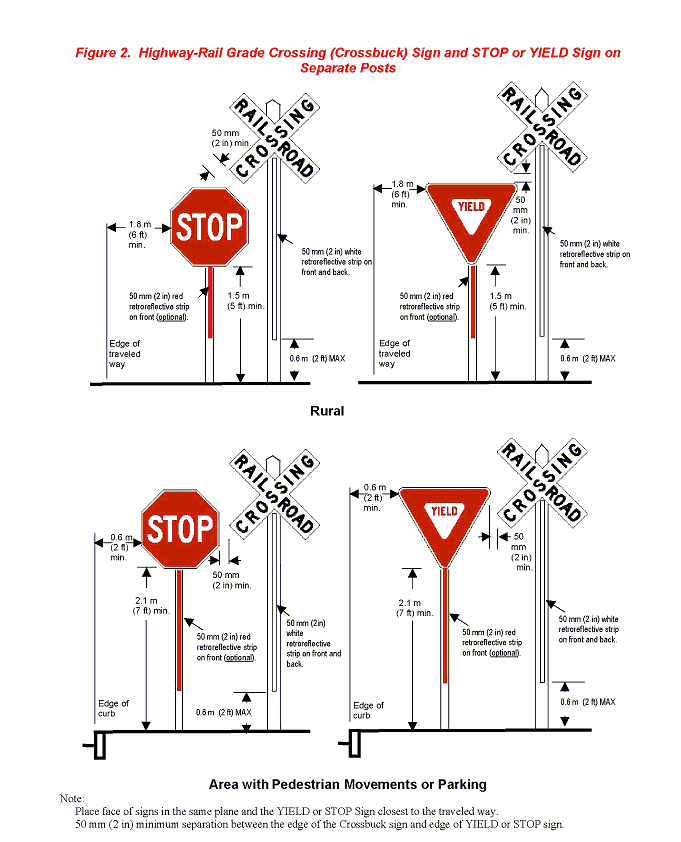| FHWA Policy Memorandums |
 |
Canceled on January 15, 2010; Superseded by the MUTCD, 2009 Edition
PDF
Version 3MB
You will need the Adobe
Acrobat Reader to view the PDF on this page.
| Memorandum |
|
| U.S. Department of Transportation | |
| Federal Highway Administration |
via Electronic Mail
| Subject: | INFORMATION:
MUTCD - Guidance for Use of YIELD or STOP Signs with the Crossbuck Sign at Passive Highway-Rail Grade Crossings |
Date:
|
March 17, 2006 |
| From: | Jeffrey
F. Paniati /s/Jeffrey F. Paniati |
Reply
to Attn of: |
HOTO-1 |
| To: | Associate
Administrators Chief Counsel Directors of Field Services Resource Center Director and Operations Managers Division Administrators Federal Lands Highway Division Engineers |
||
Background:
A number of questions have been raised regarding provisions in the Manual on Uniform Traffic Control Devices (MUTCD) governing the use of YIELD or STOP signs at passive highway-rail grade crossings, and design and placement of such signs. The purpose of this memorandum is to clarify the current MUTCD provisions as well as to provide guidance on design and placement of YIELD or STOP signs in conjunction with the Crossbuck (R15-1) sign at public passive highway-rail crossings. By definition, passive highway-rail crossings are those having warning devices such as signs and pavement markings located at or in advance of grade crossings to indicate the presence of a crossing but which do not change aspect upon the approach or presence of a train. 1
Determination of Type of Control:
The 2003 MUTCD requires the Crossbuck (R15-1) sign for all highway approaches to railroad grade crossings. It also allows the optional use of YIELD or STOP signs at passive crossings. While the Crossbuck sign is in fact a regulatory sign that requires vehicles to yield to trains and stop if necessary, recent research indicates insufficient road user understanding of and compliance with that regulatory requirement when just the Crossbuck sign is present at passive crossings. Therefore, the FHWA encourages consideration of the use of YIELD or STOP signs in conjunction with the Crossbuck sign at all passive crossings except where train crews always provide flagging to roadway users.
It is recommended that YIELD signs be considered the default choice for traffic control at a passive crossing unless an engineering study or judgment determines that a STOP sign is appropriate. A STOP sign establishes a legal requirement for each and every vehicle to come to a full stop. Indiscriminate use of the STOP sign at all or many passive grade crossings can cause poor compliance, increasing the risk of collisions associated with a high non-compliance rate. Therefore, the use of STOP signs at passive crossings should be limited to unusual conditions where requiring all vehicles to make a full stop is deemed essential by the engineering study or judgment. The engineering study or engineering judgment should consider the following factors:
Please note that certain commercial motor vehicles and school buses are required to stop at all highway-rail grade crossings, in accordance with 49 CFR 392.10, even if a YIELD sign or just a Crossbuck sign are posted.
Installation Details:
When used at a passive crossing, the YIELD or STOP sign shall be installed in conformance with the general principles and standards for sign installations in Part 2 and Part 8 of the MUTCD. In addition, the following guidance can be considered for the installation of YIELD or STOP signs at passive crossings:
Examples of design and placement of YIELD or STOP signs in conjunction with Crossbuck signs are included in the attachment for consideration by State and local agencies.
Potential Future Actions and Conclusion:
The National Committee on Uniform Traffic Control Devices (NCUTCD) has recommended revising the MUTCD to mandate use of YIELD signs at passive crossings except when STOP signs are determined appropriate by engineering study or engineering judgment. The NCUTCD's recommendation is based on the NCHRP Report 470, Traffic-Control Devices for Passive Railroad-Highway Grade Crossings. The FHWA will consider proposing changes regarding the use of YIELD or STOP signs at passive grade crossings in the next edition of the MUTCD. In the meantime, we encourage FHWA field offices to work with State and local highway agencies to promote the use of YIELD signs (or STOP signs if appropriate) at passive crossings. If there are any further questions about this issue, please contact Mr. Hari Kalla at 202-366-5915 or via e-mail hari.kalla@fhwa.dot.gov.
Attachments


|
United States Department of Transportation - Federal Highway Administration |
||